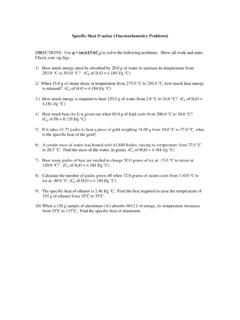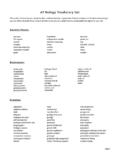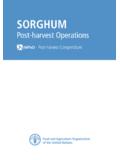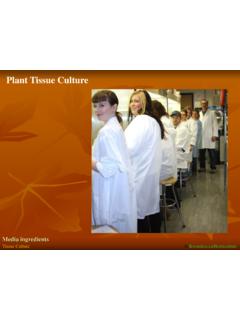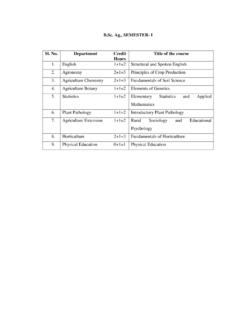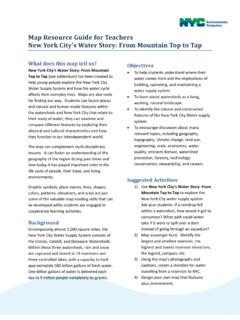Transcription of 140 Ways To Go APES - Kwanga.net
1 APES REVIEW: THE MANY ways TO GO APE(S) . Put these facts on index cards. Study them throughout the year. The underlined term or phrase goes on one side, and the definition/explanation goes on the other side. BIODIVERSITY. 1) Conservation: allowing the use of resources in a responsible manner 2) Preservation: setting aside areas and protecting them from human activities 3) Keystone species: species whose role in an ecosystem are more important than others ( sea otters, sea stars, grizzly bears, prairie dogs). 4) Indicator species: species that serve as early warnings that an ecosystem is being damaged ex.
2 Trout 5) Characteristics of endangered species: small range, large territory, or live on an island 6) Endangered species: a group of organisms in danger of becoming extinct if the situation is not improved; population numbers have dropped below the critical number of organisms; North spotted Owl (loss of old growth forest), Bald Eagle (thinning of eggs caused by DDT), Piping Plover (nesting areas threatened by development), and many others 7) Invasive/Alien/Exotic species: non-native species to an area; often thrive and disrupt the ecosystem balance; examples: kudzu vine, purple loosestrife, African honeybee killer bee , water hyacinth, fire ant, zebra mussel, gypsy moth, Asian Long Horned Beetle CYCLES/PROCESSES.
3 8) Parts of the hydrologic cycle: evaporation, transpiration , runoff, condensation, precipitation, infiltration 9) Nitrogen fixing: because atmospheric N2 cannot be used directly by plants it must first be converted into ammonia (NH3). by bacteria (rhizobium or cyanobacteria). 10) Ammonification: nitrogen is converted into ammonia by ammonifying bacteria; may occur when nitrogen in organic wastes in the soil are converted to ammonia or when atmospheric nitrogen (N2) is converted to NH3. 11) Nitrification: ammonia (NH3) is converted to nitrate ions (NO3)- 12) Assimilation: inorganic N2 is converted into organic molecules such as DNA/amino acids & proteins - plants assimilate nitrogen as NH4+ or NO3- through their roots; animals (herbivores) assimilate organic nitrogen compounds by eating plants 13) Denitrification: bacteria convert nitrate (NO3)- and nitrite (NO2)- back into N2 gas.
4 Bacteria convert ammonia (NH3) back into N2 or N2O typically accomplished by anaerobic bacteria 14) Phosphorus does not circulate as easily as nitrogen because: it does not exist as a gas, but is released by weathering of phosphate (PO4)3- rocks; this is a SEDIMENTARY cycle it is never found as a gas 15) How excess phosphorus is added to aquatic ecosystems: runoff of animal wastes, fertilizer, discharge of sewage; limiting factor in freshwater ecosystems; excess P leads to eutrophication 16) Photosynthesis: plants convert atmospheric carbon (CO2) into complex carbohydrates (glucose C6H12O6); energy is consumed and oxygen is released as a waste product 17) Aerobic respiration: O2-consuming producers, consumers & decomposers break down complex organic compounds &.
5 Convert C back into CO2; energy is released and oxygen is consumed in the process 18) Anaerobic Respiration: break down of carbohydrates without oxygen products are methane (CH4), alcohols and other organics 1. 19) transpiration process where water is absorbed by plant roots, moves up through plants, passes through pores (stomata) in leaves or other parts, evaporates into atm. as water vapor 20) Largest reservoirs of C: carbonate (CO3)2- rocks first, oceans second ECOLOGY. 21) Sustainability: the ability to meet the current needs of humanity without compromising the ability of future generations to meet their needs 22) The Tragedy of the Commons: (1968 paper by ecologist Garret Hardin) Freedom to breed is bringing ruin to all.
6 Global commons such as atmosphere & oceans are used by all and owned by none. When no individual has ownership, no one takes responsibility. Examples: overfishing in the oceans, over pumping of the Ogallala Aquifer 23) Natural selection: organisms that possess favorable adaptations survive and pass them onto the next generation 24) Energy flow in food webs or chains, through trophic systems: only 10% of the usable energy is transferred because usable energy lost as heat (second law); not all biomass is digested and absorbed; predators expend energy to catch prey.
7 The 10% value is an average value 25) Biotic and abiotic: living and nonliving components of an ecosystem 26) Competition a type of population interaction, usually over a limited resource may be intraspecific or interspecific 27) Producer/Autotroph: photosynthetic or chemosynthetic life; Chemotroph organism undergoing chemosynthesis . usually carried out by sulfur bacteria in aphotic zones in the ocean (deep ocean vents, etc.). 28) Primary succession: development of communities in a lifeless area not previously inhabited by life or those in which the soil profile is totally destroyed (lava flows); no soil substrate present; begins with lichen action 29) Secondary succession: life progresses where soil remains (clear-cut forest, fire, disturbed areas).
8 30) Mutualism: symbiotic relationship where both partners benefit and both participate 31) Commensalism: symbiotic relationship where one partner benefits & the other is unaffected or may benefit 32) Parasitism: relationship in which one partner obtains nutrients at the expense of the host 33) Biome: large distinct terrestrial region having similar climate, soil, plants terrestrial biomes determining factors are temperature and precipitation 34) Carrying capacity: the number of individuals (size of the population) that can be sustained in an area (supported by available resources in the environment).
9 35) R strategist: reproduce early in life; many small unprotected offspring; tend to be generalists, short lifespan 36) K strategist: reproduce late in life; few offspring; care for offspring; tend to be specialists, longer lifespan 37) Positive feedback: when a change in some condition triggers a response that intensifies the changing condition (warmer Earth - snow melts - less sunlight is reflected & more is absorbed, therefore warmer Earth). 38) Negative feedback: when a changing in some condition triggers a response that counteracts the changed condition (warmer Earth - more ocean evaporation - more stratus clouds - less sunlight reaches the ground - therefore cooler Earth).
10 39) Malthus: said human population increases exponentially, while food supplies increase arithmetically; factors that keep the population in check include war, famine & disease 40) Doubling time: rule of 70; 70 divided by the percent growth rate 2. 41) Replacement level fertility: the number of children a couple must have to replace themselves ( developed, developing); biotic potential; total fertility rate (TFR). 42) World Population: ~ billion Population: ~ 310 million 43) Preindustrial stage: (demographic transition) birth & death rates high, population grows slowly, infant mortality high 44) Transitional stage: (demographic transition) death rate lower, better health care, population grows fast 45) Industrial stage: (demographic transition) decline in birth rate, population growth slows 46) Postindustrial stage: (demographic transition) low birth & death rates 47) Age structure diagrams: broad base = rapid growth; narrow base = negative growth.




